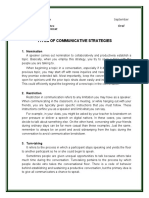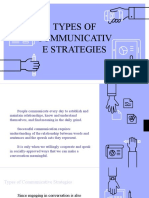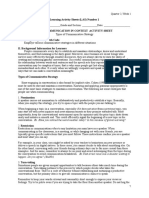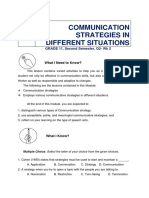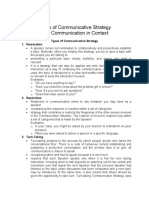0 ratings0% found this document useful (0 votes)
15 viewsUnit 2 p2 Handout
Unit 2 p2 Handout
Uploaded by
nooljohnray94This document discusses communicative strategies and effective communication. It outlines 7 types of communicative strategies: 1) Nomination, which involves collaboratively establishing topics of conversation; 2) Restriction, which refers to limitations speakers have; 3) Turn-taking, which involves deciding who speaks; 4) Topic control, which affects how topics develop formally or informally; 5) Topic shifting, which is moving from one topic to another; 6) Repair, which addresses problems in speaking, listening and comprehending; and 7) Termination, which ends topics through concluding cues. It also lists 7 effective communication strategies such as conveying points clearly, using multiple modes, being mindful of tone, and focusing on what others say through
Copyright:
© All Rights Reserved
Available Formats
Download as PDF, TXT or read online from Scribd
Unit 2 p2 Handout
Unit 2 p2 Handout
Uploaded by
nooljohnray940 ratings0% found this document useful (0 votes)
15 views1 pageThis document discusses communicative strategies and effective communication. It outlines 7 types of communicative strategies: 1) Nomination, which involves collaboratively establishing topics of conversation; 2) Restriction, which refers to limitations speakers have; 3) Turn-taking, which involves deciding who speaks; 4) Topic control, which affects how topics develop formally or informally; 5) Topic shifting, which is moving from one topic to another; 6) Repair, which addresses problems in speaking, listening and comprehending; and 7) Termination, which ends topics through concluding cues. It also lists 7 effective communication strategies such as conveying points clearly, using multiple modes, being mindful of tone, and focusing on what others say through
Original Description:
Olay lang
Original Title
Unit-2-p2-Handout
Copyright
© © All Rights Reserved
Available Formats
PDF, TXT or read online from Scribd
Share this document
Did you find this document useful?
Is this content inappropriate?
This document discusses communicative strategies and effective communication. It outlines 7 types of communicative strategies: 1) Nomination, which involves collaboratively establishing topics of conversation; 2) Restriction, which refers to limitations speakers have; 3) Turn-taking, which involves deciding who speaks; 4) Topic control, which affects how topics develop formally or informally; 5) Topic shifting, which is moving from one topic to another; 6) Repair, which addresses problems in speaking, listening and comprehending; and 7) Termination, which ends topics through concluding cues. It also lists 7 effective communication strategies such as conveying points clearly, using multiple modes, being mindful of tone, and focusing on what others say through
Copyright:
© All Rights Reserved
Available Formats
Download as PDF, TXT or read online from Scribd
Download as pdf or txt
0 ratings0% found this document useful (0 votes)
15 views1 pageUnit 2 p2 Handout
Unit 2 p2 Handout
Uploaded by
nooljohnray94This document discusses communicative strategies and effective communication. It outlines 7 types of communicative strategies: 1) Nomination, which involves collaboratively establishing topics of conversation; 2) Restriction, which refers to limitations speakers have; 3) Turn-taking, which involves deciding who speaks; 4) Topic control, which affects how topics develop formally or informally; 5) Topic shifting, which is moving from one topic to another; 6) Repair, which addresses problems in speaking, listening and comprehending; and 7) Termination, which ends topics through concluding cues. It also lists 7 effective communication strategies such as conveying points clearly, using multiple modes, being mindful of tone, and focusing on what others say through
Copyright:
© All Rights Reserved
Available Formats
Download as PDF, TXT or read online from Scribd
Download as pdf or txt
You are on page 1of 1
ORAL COMMUNICATION IN CONTEXT UNIT II (Types of Communicative Strategy)
COMMUNICATIVE STRATEGY as “What do you think?” or “You wanted to say
People communicate every day to establish and something?”
maintain relationships, know and understand 4. Topic Control
themselves, and find meaning in the daily grind. Topic control covers how procedural formality or
Moreover, since humans are social beings who survive informality affects the development of topic in
more effectively through sensible discourses, they are conversations. For example, in meetings, you may only
always driven to learn the skills of creating and have a turn to speak after the chairperson directs you to
sustaining meaningful conversations. Successful do so. Contrast this with a casual conversation with
communication requires understanding of the friends over lunch or coffee where you may take the
relationship between words and sentences and the conversational floor anytime. Remember that regardless
speech acts they represent. However, a conversation of the formality of the context, topic control is achieved
may be complex at times; that is why some people get cooperatively. This only means that when a topic is
lost along the way and misunderstand each other. It is initiated, it should be collectively developed by avoiding
only when we willingly cooperate and speak in socially unnecessary interruptions and topic shifts. You can
approved ways that we can make a conversation make yourself actively involved in the conversation
meaningful. without overly dominating it by using minimal responses
Types of Communicative Strategy like “Yes,” “Okay,” “Go on”; asking tag questions to
Since engaging in conversation is also bound by implicit clarify information briefly like “You are excited, aren’t
rules, Cohen (1990) states that strategies must be used you?”, “It was unexpected, wasn’t it?”; and even by
to start and maintain a conversation. Knowing and laughing!
applying grammar appropriately is one of the most basic 5. Topic Shifting
strategies to maintain a conversation. The following are Topic shifting, as the name suggests, involves moving
some strategies that people use when communicating. from one topic to another. In other words, it is where one
1. Nomination part of a conversation ends and where another begins.
A speaker carries out nomination to collaboratively and When shifting from one topic to another, you have to be
productively establish a topic. Basically, when you very intuitive. Make sure that the previous topic was
employ this strategy, you try to open a topic with the nurtured enough to generate adequate views. You may
people you are talking to. When beginning a topic in a also use effective conversational transitions to indicate a
conversation, especially if it does not arise from a shift like “By the way,” “In addition to what you said,”
previous topic, you may start off with news inquiries and “Which reminds me of,” and the like.
news announcements as they promise extended talk. 6. Repair
Most importantly, keep the conversational environment Repair refers to how speakers address the problems in
open for opinions until the prior topic shuts down easily speaking, listening, and comprehending that they may
and initiates a smooth end. This could efficiently signal encounter in a conversation. For example, if everybody
the beginning of a new topic in the conversation. in the conversation seems to talk at the same time, give
2. Restriction way and appreciate other’s initiative to set the
Restriction in communication refers to any limitation you conversation back to its topic. Repair is the self-righting
may have as a speaker. When communicating in the mechanism in any social interaction (Schegloff et al,
classroom, in a meeting, or while hanging out with your 1977). If there is a problem in understanding the
friends, you are typically given specific instructions that conversation, speakers will always try to address and
you must follow. These instructions confine you as a correct it. Although this is the case, always seek to
speaker and limit what you can say. For example, in initiate the repair.
your class, you might be asked by your teacher to 7. Termination
brainstorm on peer pressure or deliver a speech on Termination refers to the conversation participants’
digital natives. In these cases, you cannot decide to talk close-initiating expressions that end a topic in a
about something else. On the other hand, conversing conversation. Most of the time, the topic initiator takes
with your friends during ordinary days can be far more responsibility to signal the end of the discussion as well.
casual than these examples. Just the same, remember Although not all topics may have clear ends, try to signal
to always be on point and avoid sideswiping from the the end of the topic through concluding cues. You can
topic during the conversation to avoid communication do this by sharing what you learned from the
breakdown. conversation. Aside from this, soliciting agreement from
3. Turn-taking the other participants usually completes the discussion
Sometimes people are given unequal opportunities to of the topic meaningfully.
talk because others take much time during the 7 EFFECTIVE STRATEGIES IN COMMUNICATION
conversation. Turn-taking pertains to the process by 1. Convey important points clearly and concisely.
which people decide who takes the conversational floor. 2. Use multiple modes of communication.
There is a code of behavior behind establishing and 3. Be mindful of your tone.
sustaining a productive conversation, but the primary 4. Maintain awareness of your body language and
idea is to give all communicators a chance to speak. nonverbal cues.
Remember to keep your words relevant and reasonably 5. Know your audience.
short enough to express your views or feelings. Try to be 6. Focus on what others say and acknowledge it.
polite even if you are trying to take the floor from another 7. Request and provide feedback.
speaker. Do not hog the conversation and talk
incessantly without letting the other party air out their
own ideas. To acknowledge others, you may employ
visual signals like a nod, a look, or a step back, and you
could accompany these signals with spoken cues such
Compiled Handout by J.Nool
You might also like
- Adaptation To BereavementDocument29 pagesAdaptation To BereavementVictoria AlmeidaNo ratings yet
- Types of Communicative Strategy - HandoutDocument2 pagesTypes of Communicative Strategy - HandoutMarlon Zulueta100% (1)
- ORAL COMM L12 Communicative StrategiesDocument42 pagesORAL COMM L12 Communicative StrategiesEdgie TirolNo ratings yet
- Types of Communication StrategiesDocument8 pagesTypes of Communication StrategiesMarjorie O. MalinaoNo ratings yet
- Types of Communicative Strategies: 1. NominationDocument3 pagesTypes of Communicative Strategies: 1. NominationIan Lemuel VirtucioNo ratings yet
- Communicative StrategyDocument2 pagesCommunicative StrategyEDMAR PENUELANo ratings yet
- Types of Communicative Strategy: Lesson 1Document25 pagesTypes of Communicative Strategy: Lesson 1Joniel Niño Hora BlawisNo ratings yet
- Types of Communicative StrategyDocument46 pagesTypes of Communicative StrategyMyra Bolinas100% (1)
- Handout 1Document3 pagesHandout 1KiznaNo ratings yet
- 10 Types of Communicative StrategiesDocument10 pages10 Types of Communicative StrategiesViona NusugNo ratings yet
- ORALCOM - Communicative StrategyDocument3 pagesORALCOM - Communicative Strategykylie.snakeu22No ratings yet
- Communication StrategiesDocument9 pagesCommunication Strategiesambionred109319No ratings yet
- Types of Communicative StrategyDocument3 pagesTypes of Communicative StrategyShirley Anne ViloriaNo ratings yet
- Communicative StrategyDocument9 pagesCommunicative Strategyeldummy80No ratings yet
- 2nd Quarter Lesson 2Document6 pages2nd Quarter Lesson 2Charleston RoaNo ratings yet
- Communicative StrategyDocument14 pagesCommunicative StrategyMelissa R.Bartolay100% (2)
- Types of Communicative StrategyDocument30 pagesTypes of Communicative StrategycarumbamiashellalNo ratings yet
- Q1 Module 7 - Topic7 - Communicative StrategyDocument7 pagesQ1 Module 7 - Topic7 - Communicative StrategyKristel Ann Montiano100% (1)
- 2ND Quarter Module Oral Communication 11Document65 pages2ND Quarter Module Oral Communication 11Kem KemNo ratings yet
- Types of Communicativ E StrategiesDocument12 pagesTypes of Communicativ E StrategiesRuth Andre Bandiola100% (1)
- Lesson 3Document2 pagesLesson 3Cherryl IbarrientosNo ratings yet
- Types of Speech Style and Communicative StrategyDocument5 pagesTypes of Speech Style and Communicative StrategyGennelyn Grace Penaredondo100% (2)
- Chapter 10 Communicative StrategiesDocument4 pagesChapter 10 Communicative StrategiesCarolyn NacesNo ratings yet
- Types of Comm Strat STEM 11-BDocument2 pagesTypes of Comm Strat STEM 11-BVohn Archie EdjanNo ratings yet
- Oral-Com Q2 Week-1Document4 pagesOral-Com Q2 Week-1Auda SpringNo ratings yet
- 5 HandoutDocument9 pages5 HandoutAira GarciaNo ratings yet
- q1 Module 7 - Topic7 - Communicative StrategyDocument5 pagesq1 Module 7 - Topic7 - Communicative StrategyKristel Ann MontianoNo ratings yet
- Communicative StrategiesDocument4 pagesCommunicative Strategieshezekiah minNo ratings yet
- Communicative StrategiesDocument36 pagesCommunicative Strategiesyurisg2798No ratings yet
- Oral Communication in Context: Quarter 2 - Module 3Document12 pagesOral Communication in Context: Quarter 2 - Module 3Faith NadelaNo ratings yet
- Types of Communicative StrategyDocument12 pagesTypes of Communicative Strategyvanne cando50% (2)
- Definition of Speech ActsDocument7 pagesDefinition of Speech ActsWiljon Bermas Odi100% (1)
- Reviewer For OCCDocument5 pagesReviewer For OCCJemuel Superales NovalNo ratings yet
- Oral Communication in Context: Self-Learning ModulesDocument12 pagesOral Communication in Context: Self-Learning ModulesJennie KimNo ratings yet
- Module 6 Types of Communicative Strategies 1Document7 pagesModule 6 Types of Communicative Strategies 1Christian MonterroyoNo ratings yet
- Oral Comm. Lesson 1 Q2Document9 pagesOral Comm. Lesson 1 Q2Beth RoceroNo ratings yet
- Communicative StrategyDocument18 pagesCommunicative StrategyKeij AlolosanNo ratings yet
- Lesson 1 Communicative StrategiesDocument15 pagesLesson 1 Communicative StrategiesApril Mae JacobNo ratings yet
- TYPES of Communication STrategyDocument21 pagesTYPES of Communication STrategyReny MalayaoNo ratings yet
- Oral Comm Lesson 5Document18 pagesOral Comm Lesson 5diana cruzNo ratings yet
- OC. typesofcommunicativestrategyDocument18 pagesOC. typesofcommunicativestrategyDanilo YacapNo ratings yet
- Name: Grade Level: Section: Date:: 3. Applies Conversational and Politeness Norms For Effective CommunicationDocument11 pagesName: Grade Level: Section: Date:: 3. Applies Conversational and Politeness Norms For Effective CommunicationG'day MateNo ratings yet
- Types of Communicative StrategyDocument3 pagesTypes of Communicative StrategyCyrille GustiloNo ratings yet
- Module 8Document4 pagesModule 8Darlene Dale LapingNo ratings yet
- Types of Communicative Strategy 1. NominationDocument3 pagesTypes of Communicative Strategy 1. NominationRengie GaloNo ratings yet
- Communicative StrategyDocument2 pagesCommunicative StrategyJulieSanchezErsando100% (1)
- LECTURE-NOTES-LESSON-10-11-COMMUNICATIVE-STRATEGIES-AND-SPEECH-ACTSDocument2 pagesLECTURE-NOTES-LESSON-10-11-COMMUNICATIVE-STRATEGIES-AND-SPEECH-ACTSRoxanne Mae PuraNo ratings yet
- Communicative PPDocument9 pagesCommunicative PPAizle Trixia AlcarazNo ratings yet
- q2 Oral Com - Lesson 1Document13 pagesq2 Oral Com - Lesson 1RUBY MAE ASMOLONo ratings yet
- Reviewer On Oral Communication For 2nd QuarterDocument10 pagesReviewer On Oral Communication For 2nd QuarterNiño Ryan Ermino100% (1)
- ORAL COMM Q2 First Semester REVIEWERDocument3 pagesORAL COMM Q2 First Semester REVIEWERZhe VenturozoNo ratings yet
- Types of Communicative StrategiesDocument23 pagesTypes of Communicative StrategiesLolita QueroNo ratings yet
- Communicative StrategiesDocument3 pagesCommunicative StrategiesIza TomNo ratings yet
- Second Quarter Oral Com Topics For StudentsDocument11 pagesSecond Quarter Oral Com Topics For StudentsZion ZionNo ratings yet
- OCC Module 9Document5 pagesOCC Module 9Jessa Mae Neri SardanNo ratings yet
- Communicative StrategiesDocument4 pagesCommunicative Strategiesjian.ryccNo ratings yet
- Rogationist College Senior High School Department School Year 2017-2018Document4 pagesRogationist College Senior High School Department School Year 2017-2018gaming accountNo ratings yet
- Oral Communication 10 - STEM 11Document8 pagesOral Communication 10 - STEM 11Cyrill TagardaNo ratings yet
- Communicative Strategy: ObjectivesDocument17 pagesCommunicative Strategy: ObjectivesDenrei Keith De Jesus100% (1)
- The Power of Small Talk: Unlocking the Secrets of Casual ConversationFrom EverandThe Power of Small Talk: Unlocking the Secrets of Casual ConversationNo ratings yet
- SMALL TALK: Relationship building and the art of persuasion. How to Confide in People, Calm Your Nerves, and Boost Your Charm (2022 Guide for Beginners)From EverandSMALL TALK: Relationship building and the art of persuasion. How to Confide in People, Calm Your Nerves, and Boost Your Charm (2022 Guide for Beginners)No ratings yet
- 7.2 Final DraftDocument6 pages7.2 Final DraftQuang SamaNo ratings yet
- Behavior Based Safety & YouDocument15 pagesBehavior Based Safety & YouHaider AliNo ratings yet
- Bme 2102-m2Document4 pagesBme 2102-m2MG GadonNo ratings yet
- F MHPSS Classroom Session Guide For DistributionDocument5 pagesF MHPSS Classroom Session Guide For DistributionFaith Tulmo De DiosNo ratings yet
- 9 - Miller, Et Al. - Eight Stages of Learning Motivational InterviewingDocument16 pages9 - Miller, Et Al. - Eight Stages of Learning Motivational InterviewingLarkin McBrideNo ratings yet
- Peer Interview Matrix Terry Garland 08.2024Document4 pagesPeer Interview Matrix Terry Garland 08.2024lizrakes123No ratings yet
- A Great Wind BlowsDocument3 pagesA Great Wind BlowsDEBORAH FERNANDA SANTANA GIMENEZNo ratings yet
- My Mother at Sixty SixDocument2 pagesMy Mother at Sixty SixDA GAMERZNo ratings yet
- Ed217 Counselling SyllabusDocument3 pagesEd217 Counselling SyllabusJohn Lewis SuguitanNo ratings yet
- BPCQuestionnaireDocument6 pagesBPCQuestionnaireJwan DelawiNo ratings yet
- Judy Cameron & David Pierce - Rewards and Intrinsic MotivationDocument265 pagesJudy Cameron & David Pierce - Rewards and Intrinsic MotivationIrving Pérez MéndezNo ratings yet
- The Stages of Group DevelopmentDocument5 pagesThe Stages of Group DevelopmentSeth Elijah CaballeroNo ratings yet
- Essay FinalDocument4 pagesEssay FinalAdema NurbolatkyzyNo ratings yet
- Grad Program-2022-2023 PDFDocument34 pagesGrad Program-2022-2023 PDFrod escobarNo ratings yet
- Well Being and HappinessDocument9 pagesWell Being and HappinessBlaze 0pNo ratings yet
- Journal Prompts For Toxic RelationshipsDocument9 pagesJournal Prompts For Toxic RelationshipsAsmaa El-emairyNo ratings yet
- Chapter I. Lesson 1. An Overview of The Term CultureDocument8 pagesChapter I. Lesson 1. An Overview of The Term CultureMeralyn Puaque BustamanteNo ratings yet
- Gabres Jhon Joven Lesson Plan Grade 11Document10 pagesGabres Jhon Joven Lesson Plan Grade 11Mj GaviolaNo ratings yet
- Experiential AvoidanceDocument3 pagesExperiential AvoidancePsykey - Unlock Psychology100% (1)
- UTS (Activity Sheet 1)Document4 pagesUTS (Activity Sheet 1)Brian MirandoNo ratings yet
- Narrative Report Teenage PregnancyDocument6 pagesNarrative Report Teenage PregnancyKxyz LightNo ratings yet
- Intrapersonal CommunicationDocument12 pagesIntrapersonal CommunicationsirgeorgestorageNo ratings yet
- Coping Mechanisms of ScienceDocument26 pagesCoping Mechanisms of ScienceYouth ChoirNo ratings yet
- The Cornerstone of Every Healthy RelationshipDocument9 pagesThe Cornerstone of Every Healthy RelationshipniveditakrishnanNo ratings yet
- Borderline Personality DisorderDocument7 pagesBorderline Personality DisorderjmogikonyoNo ratings yet
- Communication Skills 331Document16 pagesCommunication Skills 331kim chanNo ratings yet
- IMT LisaBenton SudhirDocument6 pagesIMT LisaBenton Sudhirrithvik royNo ratings yet
- Verbal and Non Verbal CommunicationDocument19 pagesVerbal and Non Verbal CommunicationSeven Lyx100% (2)
- Cse JHS - MerDocument24 pagesCse JHS - MerMayda RiveraNo ratings yet




